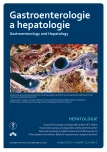A first case of electrical stimulation therapy of lower esophageal sphincter indicated in the Czech Republic for implantation
Authors:
Š. Konečný 1
; Jiří Dolina 1
; Z. Beneš 2; A. Hep 1
Authors‘ workplace:
Interní gastroenterologická klinika LF MU a FN Brno
1; Interní oddělení, Thomayerova nemocnice, Praha
2
Published in:
Gastroent Hepatol 2017; 71(2): 156-160
Category:
Clinical and Experimental Gastroenterology: Case Report
doi:
https://doi.org/10.14735/amgh2017csgh.info04
Overview
We report a case of a young 26-year-old man suffering from reflux symptoms and nonspecific esophageal dysmotility who was indicated to implantation of electrical stimulation therapy of the lower esophageal sphincter. This is the first case of use of this new surgical method for the treatment of gastroesophageal reflux disease in the Czech Republic. The patient underwent a variety of diagnostic tests, which failed to reveal other diseases besides gastroesophageal reflux disease and esophageal motility disorder. We exhausted the possibilities of conservative therapies, all of which did not significantly improve the patient’s condition. Subsequently, a consultation with a surgical department dealing with implantation of electrical stimulator of the esophagus resulted in the patient receiving approval for EndoStim implantation. Therefore, on October 14, 2015, Professor Gutt, Memmingem Chirurgische Klinik, Germany, with experience in implanting 13 EndoStim devices, performed laparoscopic hiatal hernia repair and implanted the EndoStim in the patient. The surgery was well executed without any complications and the patient was in generally good condition after the operation released home. High-resolution esophageal manometry after surgery captured rare peristaltic waves and some improvement in dysmotility. The patient is now without proton pump inhibitor medication and subjectively feels better, and according to the latest MII-pH results, is without objective signs of reflux disease. During the postoperative period, the patient only once experienced vomiting; otherwise, there was a significant improvement in overall symptoms. The patient is waiting for further examination and readjustment of therapy to optimize the outcome.
Key words:
gastroesophageal reflux disease – GERD – reflux – EndoStim
The authors declare they have no potential conflicts of interest concerning drugs, products, or services used in the study.
The Editorial Board declares that the manuscript met the ICMJE „uniform requirements“ for biomedical papers.
Submitted:
18. 4. 2016
Accepted:
3. 10. 2016
Sources
1. Vakil N, van Zanten SV, Kahrilas P et al. The Montreal definition and classification of gastroesophageal reflux disease: a global evidence-based consensus. Am J Gastroenterol 2006; 101 (8): 1900–1920.
2. El-Serag HB, Sweet S, Winchester CC et al. Update on the epidemiology of gastro-oesophageal reflux disease: a systematic review. Gut 2014; 63 (6): 871–880. doi: 10.1136/gutjnl-2012-304 269.
3. Rodríguez L, Rodriguez P, Gómez B et al. Electrical stimulation therapy of the lower esophageal sphincter is successful in treating GERD: final results of open-label prospective trial. Surg Endosc 2013; 27 (4): 1083–1092. doi: 10.1007/ s00464-012-2561-4.
4. Rodríguez L, Rodriguez P, Gómez B et al. Long-term results of electrical stimulation of the lower esophageal sphincter for the treatment of gastroesophageal reflux disease. Endoscopy 2013; 45 (8): 595–604. doi: 10.1055/s-0033-1344213.
5. Rodríguez L, Rodriguez P, Gómez B et al. Two-year results of intermittent electrical stimulation of the lower esophageal sphincter treatment of gastroesophageal reflux disease. Surgery 2015; 157 (3): 556–567. doi: 10.1016/j.surg.2014.10.012.
6. Rodríguez L, Rodriguez P, Gómez B et al. Electrical stimulation therapy of the lower esophageal sphincter is successful in treating GERD: long-term 3-year results. Surg Endosc 2016; 30 (7): 2666–2672. doi: 10.1007/s00464-015-4539-5.
7. Kappelle WF, Bredenoord AJ, Conchillo JM et al. Electrical stimulation therapy of the lower esophageal sphincter for refractory gastro-oesophageal reflux disease – interim results of an international multicentre trial. Aliment Pharmacol Ther 2015; 42 (5): 614–625. doi: 10.1111/apt.13306.
Labels
Paediatric gastroenterology Gastroenterology and hepatology SurgeryArticle was published in
Gastroenterology and Hepatology

2017 Issue 2
- Metamizole vs. Tramadol in Postoperative Analgesia
- Metamizole at a Glance and in Practice – Effective Non-Opioid Analgesic for All Ages
- Metamizole in perioperative treatment in children under 14 years – results of a questionnaire survey from practice
- The Importance of Limosilactobacillus reuteri in Administration to Diabetics with Gingivitis
Most read in this issue
- Ustekinumab – a new biological therapy for patients with Crohn’s disease
- Czech Society of Hepatology guidelines for diagnosis and treatment of acute porphyrias
- Picoprep® – a clearing agent with a new dosing schedule
- Dysphagia after anterior cervical discectomy and interbody fusion
